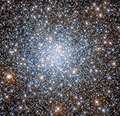Dosya:NGC6638 - HST - Potw2231a.jpg

Vervênayışê ebadê: 622 × 599 piksel. Agoznayışê bini: 249 × 240 piksel | 498 × 480 piksel | 797 × 768 piksel | 1,063 × 1,024 piksel | 2,125 × 2,048 piksel | 2,611 × 2,516 piksel.
Ebato oricinale (2,611 × 2,516 pikselan, ebatê dosya: 3.35 MB, MIME tipê cı: image/jpeg)
Verêniya dosya
Seba diyayışê viyarteyê dosya ra tarixê ke qısımê tarix/zemani derê inan bıtıkne.
| Tarix/Zeman | Resımo qıckek | Ebadi | Karber | Mışewre | |
|---|---|---|---|---|---|
| nıkayên | 19:53, 1 Tebaxe 2022 |  | 2,611 - 2,516 (3.35 MB) | Fabian RRRR | == {{int:filedesc}} == {{Information |description={{en|1='''Star-Studded Skyfield This star-studded image from the NASA/ESA Hubble Space Telescope shows the heart of the globular cluster NGC 6638 in the constellation Sagittarius. The star-strewn observation highlights the density of stars at the heart of globular clusters, which are stable, tightly bound clusters of tens of thousands to millions of stars. To capture the data in this image, Hubble used two of its cutting-edge astronomical in... |
Gurenayışê dosya
The following pages link to this file:
Gurenayışê dosyaya gılovere
Ena dosya wikiyanê binan de gureniyena.
- ar.wikipedia.org sero guriyayış
- ce.wikipedia.org sero guriyayış
- de.wikipedia.org sero guriyayış
- en.wikipedia.org sero guriyayış
- eo.wikipedia.org sero guriyayış
- es.wikipedia.org sero guriyayış
- eu.wikipedia.org sero guriyayış
- fr.wikipedia.org sero guriyayış
- nl.wikipedia.org sero guriyayış
- tt.wikipedia.org sero guriyayış
- www.wikidata.org sero guriyayış

